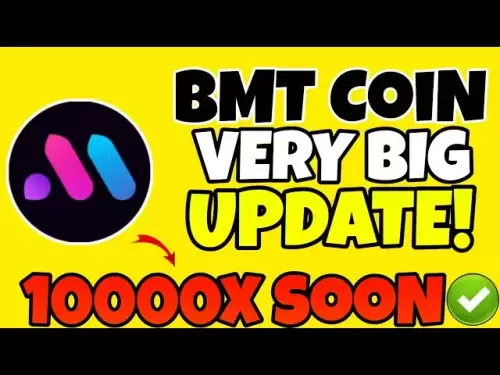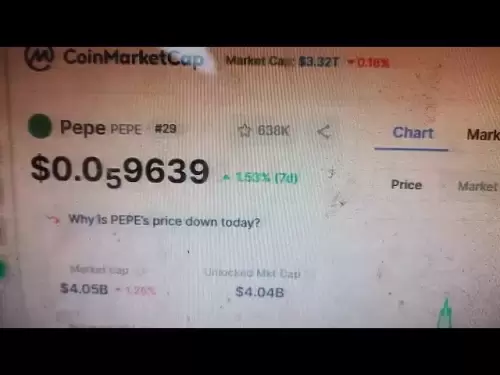-
 Bitcoin
Bitcoin $108,962.3544
0.69% -
 Ethereum
Ethereum $2,563.3189
1.78% -
 Tether USDt
Tether USDt $1.0003
0.00% -
 XRP
XRP $2.2768
2.22% -
 BNB
BNB $661.4562
0.97% -
 Solana
Solana $151.7146
2.47% -
 USDC
USDC $1.0000
0.00% -
 TRON
TRON $0.2847
0.18% -
 Dogecoin
Dogecoin $0.1713
4.43% -
 Cardano
Cardano $0.5848
1.78% -
 Hyperliquid
Hyperliquid $39.5345
-0.06% -
 Sui
Sui $2.9384
1.25% -
 Bitcoin Cash
Bitcoin Cash $492.0864
1.54% -
 Chainlink
Chainlink $13.4271
1.89% -
 UNUS SED LEO
UNUS SED LEO $9.0294
0.07% -
 Avalanche
Avalanche $18.1886
1.61% -
 Stellar
Stellar $0.2430
2.48% -
 Toncoin
Toncoin $2.9054
6.05% -
 Shiba Inu
Shiba Inu $0.0...01186
3.57% -
 Litecoin
Litecoin $88.0187
1.46% -
 Hedera
Hedera $0.1574
1.38% -
 Monero
Monero $315.1335
0.11% -
 Polkadot
Polkadot $3.3994
1.47% -
 Dai
Dai $1.0000
0.00% -
 Ethena USDe
Ethena USDe $1.0002
0.01% -
 Bitget Token
Bitget Token $4.4220
0.86% -
 Uniswap
Uniswap $7.4330
7.03% -
 Pepe
Pepe $0.0...01010
4.10% -
 Aave
Aave $277.8377
2.41% -
 Pi
Pi $0.4572
-0.22%
How to track and analyze the changes in SUI whale addresses?
Track SUI whale addresses using blockchain explorers and analytics platforms to monitor large holders' transactions and gain insights into market trends.
Apr 27, 2025 at 09:42 am

Tracking and analyzing the changes in SUI whale addresses involves several steps and tools that can help you monitor the movements of large holders of SUI cryptocurrency. Whale addresses, often referred to as those holding significant amounts of a cryptocurrency, can provide valuable insights into market trends and potential price movements. Here’s a comprehensive guide on how to effectively track and analyze these changes.
Understanding SUI Whale Addresses
SUI whale addresses are cryptocurrency wallets that hold a large amount of SUI tokens. These addresses are often owned by institutional investors, large trading firms, or wealthy individuals. Monitoring these addresses can give you a glimpse into the actions of major players in the SUI ecosystem, which can be crucial for making informed investment decisions.
To begin tracking these whale addresses, you first need to identify them. This can be done using blockchain explorers and analytics platforms that provide detailed information about transactions and wallet balances.
Using Blockchain Explorers
Blockchain explorers are essential tools for tracking cryptocurrency transactions. For SUI, you can use a dedicated SUI blockchain explorer to monitor whale addresses. Here's how you can use a blockchain explorer to track SUI whale addresses:
- Visit the SUI blockchain explorer: Navigate to a reputable SUI blockchain explorer website.
- Search for large transactions: Use the search function to look for transactions involving large amounts of SUI. You can filter transactions by amount to focus on significant movements.
- Identify whale addresses: Once you find large transactions, note the addresses involved. These are likely to be whale addresses.
- Monitor these addresses: Add these addresses to your watchlist on the blockchain explorer to keep track of their future transactions.
Utilizing Analytics Platforms
Analytics platforms offer more advanced features for tracking and analyzing whale addresses. These platforms can provide real-time data, historical transaction data, and even predictive analytics based on whale movements. Here’s how to use an analytics platform for tracking SUI whale addresses:
- Choose a reliable analytics platform: Select a platform that supports SUI and offers detailed analytics for whale addresses.
- Input whale addresses: Enter the whale addresses you identified using the blockchain explorer into the analytics platform.
- Analyze transaction patterns: Use the platform’s tools to analyze the transaction history of these addresses. Look for patterns such as accumulation or distribution phases.
- Set up alerts: Configure alerts for significant movements from these addresses to stay updated on their activities.
Analyzing Whale Address Movements
Once you have identified and started tracking SUI whale addresses, the next step is to analyze their movements. This involves looking at the volume, frequency, and direction of their transactions. Here’s how to analyze these movements:
- Volume analysis: Monitor the volume of SUI tokens being moved in and out of whale addresses. Large volumes can indicate significant market moves.
- Frequency analysis: Look at how often these addresses are making transactions. A sudden increase in transaction frequency could signal upcoming market changes.
- Direction analysis: Determine whether the whale addresses are accumulating (buying) or distributing (selling) SUI tokens. This can give you insights into their market sentiment.
Using On-Chain Metrics
On-chain metrics are another valuable tool for analyzing SUI whale addresses. These metrics provide quantitative data that can help you understand the behavior of whale addresses. Some key on-chain metrics to consider include:
- Transaction count: The number of transactions from a whale address can indicate its activity level.
- Balance changes: Monitoring the balance changes of whale addresses can help you track their accumulation or distribution activities.
- Network growth: The number of new addresses interacting with whale addresses can provide insights into the network’s growth and whale influence.
To use on-chain metrics effectively, you can use specialized on-chain analytics tools that provide detailed data and visualizations. These tools can help you spot trends and patterns that may not be immediately visible through simple transaction tracking.
Combining Data from Multiple Sources
For a comprehensive analysis of SUI whale addresses, it’s important to combine data from multiple sources. This can include data from blockchain explorers, analytics platforms, and on-chain metrics tools. By integrating these different sources, you can get a more complete picture of whale activities.
- Integrate blockchain explorer data: Use the transaction data from blockchain explorers to identify whale addresses and monitor their movements.
- Combine with analytics platform data: Use the advanced analytics features of analytics platforms to analyze the transaction patterns and predict potential market moves.
- Incorporate on-chain metrics: Use on-chain metrics to add quantitative data to your analysis, helping you understand the broader context of whale activities.
Practical Example: Tracking a SUI Whale Address
Let’s walk through a practical example of how to track and analyze a SUI whale address. Suppose you have identified a whale address with a significant SUI balance using a blockchain explorer. Here’s how you can proceed:
- Add the address to your watchlist: On the blockchain explorer, add the whale address to your watchlist to monitor its future transactions.
- Enter the address into an analytics platform: Input the whale address into your chosen analytics platform to access more detailed data and analysis tools.
- Analyze transaction history: Use the analytics platform to review the transaction history of the whale address. Look for patterns such as regular accumulation or sudden distribution.
- Set up transaction alerts: Configure alerts on the analytics platform to notify you of significant transactions from the whale address.
- Monitor on-chain metrics: Use on-chain metrics tools to track changes in the whale address’s balance and transaction count over time.
- Combine data for analysis: Integrate the data from the blockchain explorer, analytics platform, and on-chain metrics to gain a comprehensive understanding of the whale address’s activities.
By following these steps, you can effectively track and analyze the changes in SUI whale addresses, helping you make more informed decisions in the cryptocurrency market.
Frequently Asked Questions
Q: Can tracking SUI whale addresses help predict market trends?
A: While tracking SUI whale addresses can provide valuable insights into large holders' activities, it is not a foolproof method for predicting market trends. Whale movements can influence the market, but they are just one of many factors to consider.
Q: How often should I check for updates on SUI whale addresses?
A: The frequency of checking for updates depends on your investment strategy and the volatility of the SUI market. For active traders, daily checks might be necessary, while long-term investors might check weekly or monthly.
Q: Are there any risks associated with relying on whale address data?
A: Yes, there are risks. Whale movements can be misleading, and relying solely on this data can lead to misinformed decisions. It's important to use whale address data as part of a broader analysis that includes other market indicators and fundamental analysis.
Q: Can I automate the tracking of SUI whale addresses?
A: Yes, many analytics platforms offer automation features that allow you to set up alerts and receive notifications about significant movements from whale addresses. This can help you stay updated without manually checking the data.
Disclaimer:info@kdj.com
The information provided is not trading advice. kdj.com does not assume any responsibility for any investments made based on the information provided in this article. Cryptocurrencies are highly volatile and it is highly recommended that you invest with caution after thorough research!
If you believe that the content used on this website infringes your copyright, please contact us immediately (info@kdj.com) and we will delete it promptly.
- Litecoin Breakout Watch: What Traders Need to Know Now
- 2025-07-06 16:50:13
- Bitcoin, Solana, Ethereum: Decoding the Latest Buzz on the Blockchain
- 2025-07-06 16:50:13
- Widnes Resident's 50p Could Be Your Ticket to Easy Street: Rare Coin Mania!
- 2025-07-06 16:55:13
- Bitcoin, Solaris Presale, and Token Rewards: What's the Buzz?
- 2025-07-06 16:55:13
- Ethereum Under Pressure: Price Drop Amid Global Uncertainties
- 2025-07-06 17:00:13
- XRP, SEC Case, and Prosperity: A New Era for XRP Holders?
- 2025-07-06 17:10:13
Related knowledge

How to customize USDT TRC20 mining fees? Flexible adjustment tutorial
Jun 13,2025 at 01:42am
Understanding USDT TRC20 Mining FeesMining fees on the TRON (TRC20) network are essential for processing transactions. Unlike Bitcoin or Ethereum, where miners directly validate transactions, TRON uses a delegated proof-of-stake (DPoS) mechanism. However, users still need to pay bandwidth and energy fees, which are collectively referred to as 'mining fe...

USDT TRC20 transaction is stuck? Solution summary
Jun 14,2025 at 11:15pm
Understanding USDT TRC20 TransactionsWhen users mention that a USDT TRC20 transaction is stuck, they typically refer to a situation where the transfer of Tether (USDT) on the TRON blockchain has not been confirmed for an extended period. This issue may arise due to various reasons such as network congestion, insufficient transaction fees, or wallet-rela...

How to cancel USDT TRC20 unconfirmed transactions? Operation guide
Jun 13,2025 at 11:01pm
Understanding USDT TRC20 Unconfirmed TransactionsWhen dealing with USDT TRC20 transactions, it’s crucial to understand what an unconfirmed transaction means. An unconfirmed transaction is one that has been broadcasted to the blockchain network but hasn’t yet been included in a block. This typically occurs due to low transaction fees or network congestio...

How to check USDT TRC20 balance? Introduction to multiple query methods
Jun 21,2025 at 02:42am
Understanding USDT TRC20 and Its ImportanceUSDT (Tether) is one of the most widely used stablecoins in the cryptocurrency market. It exists on multiple blockchain networks, including TRC20, which operates on the Tron (TRX) network. Checking your USDT TRC20 balance accurately is crucial for users who hold or transact with this asset. Whether you're sendi...

What to do if USDT TRC20 transfers are congested? Speed up trading skills
Jun 13,2025 at 09:56am
Understanding USDT TRC20 Transfer CongestionWhen transferring USDT TRC20, users may occasionally experience delays or congestion. This typically occurs due to network overload on the TRON blockchain, which hosts the TRC20 version of Tether. Unlike the ERC20 variant (which runs on Ethereum), TRC20 transactions are generally faster and cheaper, but during...

The relationship between USDT TRC20 and TRON chain: technical background analysis
Jun 12,2025 at 01:28pm
What is USDT TRC20?USDT TRC20 refers to the Tether (USDT) token issued on the TRON blockchain using the TRC-20 standard. Unlike the more commonly known ERC-20 version of USDT (which runs on Ethereum), the TRC-20 variant leverages the TRON network's infrastructure for faster and cheaper transactions. The emergence of this version came as part of Tether’s...

How to customize USDT TRC20 mining fees? Flexible adjustment tutorial
Jun 13,2025 at 01:42am
Understanding USDT TRC20 Mining FeesMining fees on the TRON (TRC20) network are essential for processing transactions. Unlike Bitcoin or Ethereum, where miners directly validate transactions, TRON uses a delegated proof-of-stake (DPoS) mechanism. However, users still need to pay bandwidth and energy fees, which are collectively referred to as 'mining fe...

USDT TRC20 transaction is stuck? Solution summary
Jun 14,2025 at 11:15pm
Understanding USDT TRC20 TransactionsWhen users mention that a USDT TRC20 transaction is stuck, they typically refer to a situation where the transfer of Tether (USDT) on the TRON blockchain has not been confirmed for an extended period. This issue may arise due to various reasons such as network congestion, insufficient transaction fees, or wallet-rela...

How to cancel USDT TRC20 unconfirmed transactions? Operation guide
Jun 13,2025 at 11:01pm
Understanding USDT TRC20 Unconfirmed TransactionsWhen dealing with USDT TRC20 transactions, it’s crucial to understand what an unconfirmed transaction means. An unconfirmed transaction is one that has been broadcasted to the blockchain network but hasn’t yet been included in a block. This typically occurs due to low transaction fees or network congestio...

How to check USDT TRC20 balance? Introduction to multiple query methods
Jun 21,2025 at 02:42am
Understanding USDT TRC20 and Its ImportanceUSDT (Tether) is one of the most widely used stablecoins in the cryptocurrency market. It exists on multiple blockchain networks, including TRC20, which operates on the Tron (TRX) network. Checking your USDT TRC20 balance accurately is crucial for users who hold or transact with this asset. Whether you're sendi...

What to do if USDT TRC20 transfers are congested? Speed up trading skills
Jun 13,2025 at 09:56am
Understanding USDT TRC20 Transfer CongestionWhen transferring USDT TRC20, users may occasionally experience delays or congestion. This typically occurs due to network overload on the TRON blockchain, which hosts the TRC20 version of Tether. Unlike the ERC20 variant (which runs on Ethereum), TRC20 transactions are generally faster and cheaper, but during...

The relationship between USDT TRC20 and TRON chain: technical background analysis
Jun 12,2025 at 01:28pm
What is USDT TRC20?USDT TRC20 refers to the Tether (USDT) token issued on the TRON blockchain using the TRC-20 standard. Unlike the more commonly known ERC-20 version of USDT (which runs on Ethereum), the TRC-20 variant leverages the TRON network's infrastructure for faster and cheaper transactions. The emergence of this version came as part of Tether’s...
See all articles

























































































